Deirdre Finnerty
Unheralded Stories by Tom Hunter was exhibited for the first time in Wales at Mission Gallery in Swansea from May 18th – July 14th 2013. It coincided with Diffusion, Cardiff’s International Photography Festival organized by Ffotogallery as a satellite venue with the majority of artists exhibiting at Cardiff venues. First shown at Purdy Hicks Gallery in London in 2010, presented here are five of the ten images that make up the series shown for the first time alongside five smaller pinhole photographs. Hunter is an internationally renowned artist based in London, UK. He graduated from the London College of Printing in 1994 and his degree show, The Ghetto, a series of photographs and a model of Hunter’s squatted neighborhood of Hackney, London, is now on permanent display in the Museum of London. Hunter is Professor of Photography at the London College of Communication, University of the Arts London. He gave a private talk to the staff of Mission Gallery and I also attended The Association of Photography in Higher Education (A.P.H.E.) Photography Conference reception that was held at Mission Gallery on July 10th 2013 in which Paul Duerinckx, Head of the BA (Hons) Photojournalism degree program at Swansea Metropolitan, was in conversation with Tom Hunter on the theme of ‘Issues of Ethics in Photography Education’.
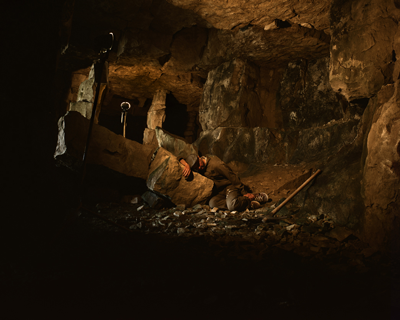
Tom Hunter, Mole Man, 2010. C-type print. Image courtesy Tom Hunter, and Purdy Hicks Gallery.

Tom Hunter, Hide and Seek, 2010. C-type print. Image courtesy Tom Hunter, and Purdy Hicks Gallery.
To place Hunter’s work in Mission Gallery is a clever curatorial move as its interior is one that you would expect to appear in Hunter’s work. Mission Gallery’s history and architecture elevate the reception of Hunter’s artworks as the building continues to resonate with its previous life as St Nicholas’ Church. It was built by Benjamin Bucknall in 1858 for the seafarers that came to Swansea’s port. It was a place for prayer and a place for rest and respite, a necessary place for worship in that time. The presentation and placement of these images in this space hark back to paintings and murals of icons, saints and martyrs found in Christian churches and cathedrals throughout history. Hunter describes them as being like altar pieces he has seen in Italy. They were traditionally used as teaching aids; it was the only way to communicate and educate people about their lifestyle choices in a Catholic world and the narrative in these images is unavoidable. Galleries and museums are like modern cathedrals as people come en masse to view the wonders inside like a pilgrimage to see a relic.
Hunter’s fictitious scenes are taken from the Old Masters’ tableaux paintings depicting epic scenes that portray exotic and mystical stories and people. Hunter utilizes this technique but updates it and localizes it to show that you do not need to travel to distant lands to find the exotic. He takes his photographs in his neighborhood of Hackney based on stories, fables and myths that people have told him. He takes these dull, exciting and ordinary stories and makes them into epic tableaux paintings, expressing how paintings were the photographs of the time. In his talk, the artist indicated that the exotic does not have to be something geographically distant, but rather a property that can be close to home. And this closeness should be celebrated.
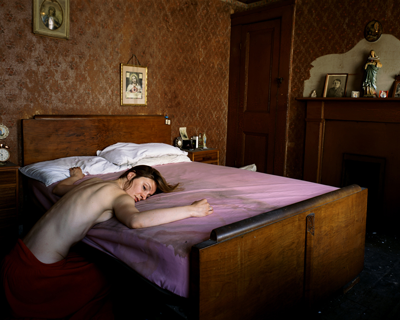
Tom Hunter, Death of Coltelli 2010. C-type print. Image courtesy Tom Hunter, and Purdy Hicks Gallery.
Death of Coltelli (2010) is based on the painting ‘Death of Sardanapalus’ (1827) by Eugène Delacroix in which the Sultan has died and his harem is being put to death around him, showing a mystique that was found in the Middle East. Hunter has photographed the granddaughter of an Italian woman who ran a café in Hackney. The woman is strewn half on the bed facing a fireplace whose mantel piece holds a photograph of the Italian matriarch. Resembling a shrine, the scene references Italian catholic heritage that is woven into British society; the café evolved from serving pasta dishes to eggs, beans and chips – a typical British dish. Hunter attempts to enable the viewer to reconsider their typical perceptions of their neighbours in employing the art historical emphasis on beauty.
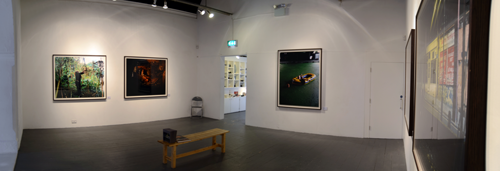
Installation at Mission Gallery of Tom Hunter, Unheralded Stories, 2010. C-type prints. Images courtesy Tom Hunter, and Purdy Hicks Gallery.
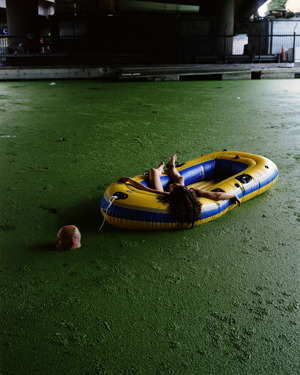
Tom Hunter, Hackney Cut, 2010. C-type print. Image courtesy Tom Hunter, and Purdy Hicks Gallery.
As you enter the exhibition space you look for a place to start; perhaps you begin on your left with Hackney Cut – an image of a ‘skinhead’, with his head just above the waterline, pulling a bright yellow dinghy with a beautiful reclining maiden on a river green with algae under a bridge in Hackney. Hackney Cut, as Hunter states, is a direct reference to the 1979 film ‘Apocalypse Now’ and also describes his approach to photography as making something beautiful out of a catastrophe. Then the viewer might move around the space spending time at each photograph to find the narrative in each image. There is an uncanny site-specific action taking place that strikes a likeness to viewing the Stations of the Cross in a church. Contemplate: find the lesson, what is the moral of this story? And how does this apply to me?
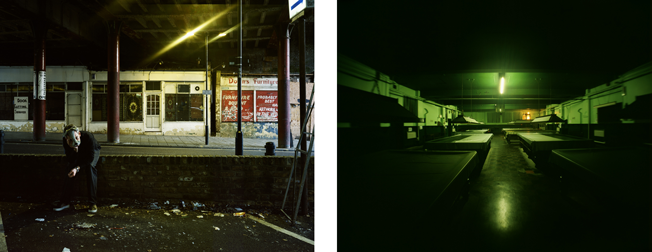
Tom Hunter Fall of the Night & Snooker Hall, 2010. C-type prints. Image courtesy Tom Hunter, and Purdy Hicks Gallery.
Immense images in dark wood frames in the square space are mirrored by smaller contextual images placed in the curve of the church’s apse. This is a set of five pinhole photographs show fictional contexts for each of the characters: a school hall, a church, a working men’s club, a social club and a snooker hall. The connections are not explicit. Investigate and it will become clear whose world you are peering into. A greenly glowing snooker hall empty in the early hours is perhaps the origin of the partied-out character in Fall of the Night sitting lonely in greenish surroundings under a highway wearing a furry grey mouse mask. One in particular has carpets covering the windows suggesting a magnificent Aladdin’s cave is just behind that door in Hackney, London.
Having listened to Hunter speak about his work and technique, I asked him why he used a pinhole camera to take the images of the interior spaces that were displayed in the apse of Mission Gallery. These images show the interior spaces of a school hall, a social club, a community hall, a working men’s club and a snooker hall: stages and enactments of his photographed people. Quite a few of Mission Gallery’s visitors think that Hunter must have shot these in Swansea which shows that there is something “about the universal spaces that people do know and inhabit and feel familiar with” (Hunter, T. personal communication, July 10th 2013)
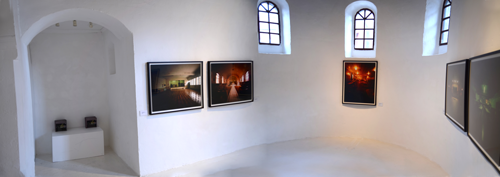
Installation at Mission Gallery of Tom Hunter, Unheralded Stories, 2010. C-type prints. Images courtesy Tom Hunter, and Purdy Hicks Gallery.
Hunter used a pinhole camera to take the photographs of the empty spaces around Hackney. These were displayed in the apse of Mission Gallery giving context to the characters in the larger images. When asked ‘why?’ he explained that he did not want to just ‘snap’ and ‘take’ photographs, an ‘anti-shooting/grabbing’ methodology, in order to respect and capture and absorb the essence of these spaces. It is respectful of the nature of the spaces; he slows the process down and absorbs light and atmosphere.

Tom Hunter Death of Coltelli & Catholic Church, 2010. C-type prints. Image courtesy Tom Hunter, and Purdy Hicks Gallery.
“These places are like shrines” he said (personal communication, July, 10th 2013). To me, the effect of the image captured by the pinhole camera evokes peering into someone else’s world, through a peep-hole, someone’s personal space. The spaces, although empty, exude a sense of presence as if the people in the larger photographs have just been there. Perhaps the spiritual quality of the spaces and the gallery heightens the perceptions of all of these photographs. Are they really just ordinary people from Hackney? Or are they real life saints and martyrs?
“The stage on which we move begins already before but is as near as your own front door. And what lies beyond can be made and reshaped as never before. This is the subject of Tom Hunter’s art.” (Slyce, 2010)
Reference
Slyce, J. Unheralded Stories [Internet] (London). Available from: http://www.tomhunter.org/tom-hunter-shows-unheralded-stories-at-mission-gallery-swansea/ Accessed July 19th 2013
Deirdre Finnerty is the Exhibitions & Marketing Assistant at Mission Gallery, Swansea, UK. She recently completed a Masters in Glass at Swansea Metropolitan, University of Wales Trinity Saint David.